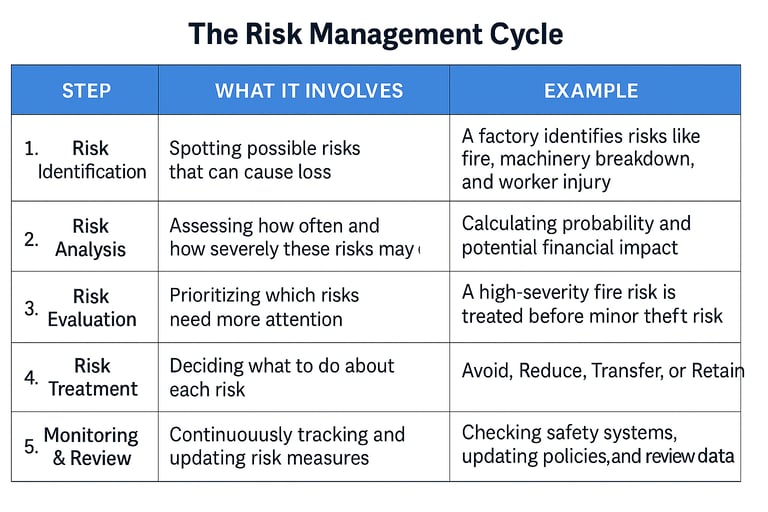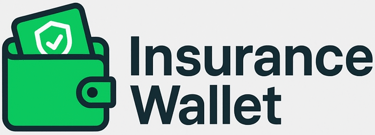🧭 The Role of Risk Management in Modern Insurance
🌟 Introduction
In today’s fast-changing world, risks are everywhere — from natural disasters and cyberattacks to global health crises and financial instability.
The insurance industry stands at the center of all this uncertainty.
But insurance doesn’t just react to risk — it also helps to manage it.
This is where Risk Management plays a powerful and essential role.
🔍 What is Risk Management?
Risk Management is the process of identifying, analyzing, and dealing with the risks that individuals or organizations face.
In simple terms:
“Risk Management means understanding what could go wrong — and preparing for it before it happens.”
For insurance companies, risk management is both a defensive shield and a decision-making tool.
It helps them control losses, keep premiums reasonable, and protect the interests of policyholders.
🏗️ The Risk Management Process
The risk management cycle typically includes five main steps:
⚙️ Methods of Risk Treatment
Risk Management doesn’t just identify problems — it provides practical ways to handle them.
Here are the four major methods insurers and businesses use:
1️⃣ Avoidance
Don’t take the risk at all.
Example: A company avoids setting up a plant in an earthquake-prone area.
2️⃣ Reduction (or Mitigation)
Take steps to reduce either the chance or the severity of loss.
Example: Installing fire alarms, CCTV cameras, and safety drills.
3️⃣ Transfer
Shift the financial impact of risk to another party — and this is where insurance comes in!
Example: Buying fire or health insurance transfers the cost of potential loss to the insurer.
4️⃣ Retention
Keep and manage some part of the risk yourself.
Example: A company creates a reserve fund to handle small damages instead of claiming every time.
🛡️ How Risk Management Supports the Insurance Industry
Insurance is actually one part of risk management, but it also depends on risk management to function effectively.
Let’s see how:
🔹 1. Helps Insurers Price Risks Accurately
Insurers use risk data to decide premium rates.
Better understanding of frequency and severity helps avoid underpricing or overpricing.
🔹 2. Reduces Losses and Improves Profitability
By encouraging clients to adopt preventive measures, insurers reduce claim frequency.
Example: Motor insurers promote safe driving discounts.
🔹 3. Strengthens Underwriting
Underwriters rely on risk management insights to decide which risks to accept and which to reject.
🔹 4. Enhances Customer Trust
When clients see insurers promoting safety and prevention, they view insurance as a partner, not just a seller of policies.
🔹 5. Stabilizes the Insurance Market
Risk management ensures fewer surprises. Predictable losses mean a more stable, reliable insurance market.
🌍 Risk Management in the Modern Era
The role of risk management has expanded beyond traditional risks like fire, theft, or accidents.
Today’s insurers face new-age threats:
Cyber Risks – data breaches, hacking, identity theft
Climate Risks – floods, wildfires, rising sea levels
Pandemic Risks – health crises disrupting business and travel
Reputational Risks – brand damage through social media
Supply Chain Risks – global dependence causing business disruption
Modern insurance companies use advanced analytics, artificial intelligence (AI), and big data to forecast, prevent, and manage such risks.
So, risk management today isn’t just about reacting — it’s about predicting and preventing.
📘 Real-Life Example
During the COVID-19 pandemic, insurers faced a sudden spike in health and business interruption claims.
Companies with strong risk management strategies — including reinsurance, diversified portfolios, and digital claim systems — managed to stay stable and serve customers efficiently.
This shows how effective risk management can protect both the insurer and the insured in times of global crisis.
🧠 Quick Recap
Risk Management = Identifying + Assessing + Treating + Monitoring Risks.
Insurance is a risk transfer tool, but it works best when combined with other risk management measures.
Modern risk management uses data, technology, and foresight to handle emerging risks.
Strong risk management = Stable insurance companies + Secure policyholders.
💡 Key Takeaways for Agents
✅ Understand risk management as the foundation of insurance practice.
✅ Educate clients that insurance is not the first step, but part of a bigger safety plan.
✅ Promote risk awareness — prevention is cheaper than a claim!
✅ For exams, remember this simple line:
“Risk Management helps identify, evaluate, and control risks — and insurance is one vital method of risk transfer.”


